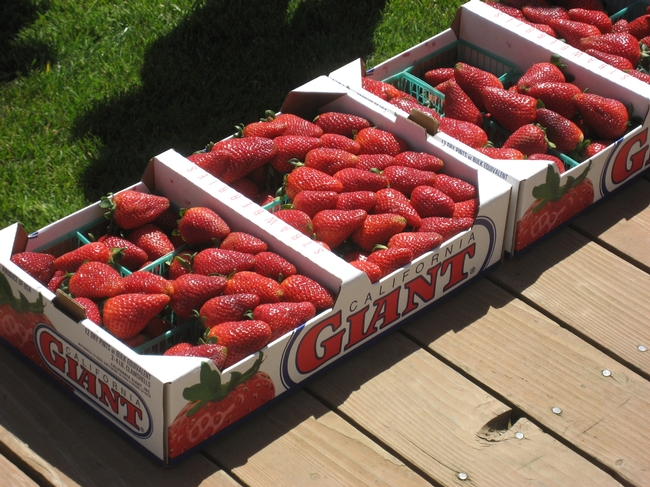Posts Tagged: strawberry
UC estimates costs for growing strawberries on coast
New studies showing production costs for strawberries in three of California’s coastal growing regions are now available from the University of California Cooperative Extension. The studies estimate costs for producing strawberries in the Santa Maria Valley, Oxnard Plain and Santa Cruz and Monterey counties.
Each analysis is based upon hypothetical farm operations using practices common in the region. Input and reviews were provided by UC Cooperative Extension farm advisors, UC researchers, growers, farm accountants, pest control advisers, consultants and other agricultural associates.
The studies describe the assumptions used to identify current costs for the individual crops, material inputs, cash and non-cash overhead. A ranging analysis table shows profits over a range of prices and yields. Other tables show the monthly cash costs, the costs and returns per acre, hourly equipment costs, and the whole farm annual equipment, investment, and business overhead costs.
The new studies are as follows:
Sample Costs to Produce Strawberries, 2011, South Coast Region (Santa Maria Valley) by Surendra Dara, Karen M. Klonsky and Richard L. De Moura.
Sample Costs to Produce Strawberries, 2011, South Coast Region (Oxnard Plain) by Oleg Daugovish, Karen M. Klonsky and Richard L. De Moura.
Sample Costs to Produce Second Year Strawberries, 2011, Central Coast Region (Santa Cruz & Monterey Counties) by Mark P. Bolda, Laura Tourte, Karen M. Klonsky and Richard L. De Moura.
All cost of production studies are available for free download at http://coststudies.ucdavis.edu, at UC Cooperative Extension offices or by calling (530) 752-3589. For more information about the studies, contact Richard De Moura at rdemoura@ucdavis.edu in the Department of Agricultural and Resource Economics at UC Davis.
New film traps fumigants and increases strawberry yields
Producing 85 percent of the nation’s strawberries, California growers urgently need alternatives to methyl bromide fumigation if they are to maintain yields. Methyl bromide has been phased out for all but critical uses because it depletes ozone in the upper atmosphere.
UC scientists now report that use of totally impermeable film in strawberry fields can improve the effectiveness of a widely-used MB alternative known as 1,3-D (1,3, dichloropropene). Use of the film reduces the amount of 1,3-D needed to maintain yields, while lowering field emissions overall.
The strawberry industry is highly dependent on soil fumigation to control pests and maintain high yields. The methyl bromide alternative, 1,3-D, can be used only in certain quantities, due to air quality concerns.
In a recent trial, totally impermeable film (TIF) was laid out over Salinas fields to prevent the fumigant from leaking. The new film was compared with the standard film used by growers. Fumigant concentrations under TIF were 46 percent to 54 percent higher than under standard film, and the higher concentrations were correlated with higher strawberry yields and better weed control. Scientists report these findings in detail in the October–December 2011 electronic edition of the University of California’s California Agriculture journal.
Impermeable films have three benefits, according to lead author Steven Fennimore, UC Cooperative Extension specialist and weed scientist in UC Davis Department of Plant Sciences. The films trap the fumigant in the soil for a longer time and thereby increase its effectiveness; they reduce fumigant emissions, which after reacting with nitrogen oxides, can convert to ground-level ozone; and they reduce the amount of fumigant needed for effective pest control.
Emissions are a chief concern. Methyl bromide, a widely used fumigant in combination with chloropicrin, has been phased out since 2005 because it is an ozone-depleting substance targeted by the Montreal Protocol (a global treaty to control ozone depletion) and the U.S. Clean Air Act. However, it is still being used in some California strawberry fields under a critical-use exemption. Restrictions on the use of 1,3-D to 90,250 pounds per 36-square-mile township (called the township cap) leave few other options for growers in key strawberry production areas near densely populated areas.
Comparing TIF with standard film, and methyl bromide plus chloropicrin with varying amounts of 1,3-D plus chloropicrin, the scientists rated the effectiveness of TIF. The results, writes Fennimore, suggest that to achieve fruit yield and weed control similar to methyl bromide and chloropicrin, 33 percent less 1,3-D plus chloropicrin is needed under TIF than standard films.
TIF may ease some of the burdens of fumigant regulations on end-users, as well as ease concerns of the general public about exposure to fumigants, he concludes.
The entire October–December 2011 issue, and the electronic edition, can be viewed and downloaded at http://californiaagriculture.ucanr.org.
California Agriculture is the University of California’s peer-reviewed journal of research in agricultural, human and natural resources. For a free subscription, visit http://californiaagriculture.ucanr.org, or write to calag@ucdavis.edu.
###
WRITERS/EDITORS: To request a hard copy of the journal, email crllopez@ucdavis.edu


